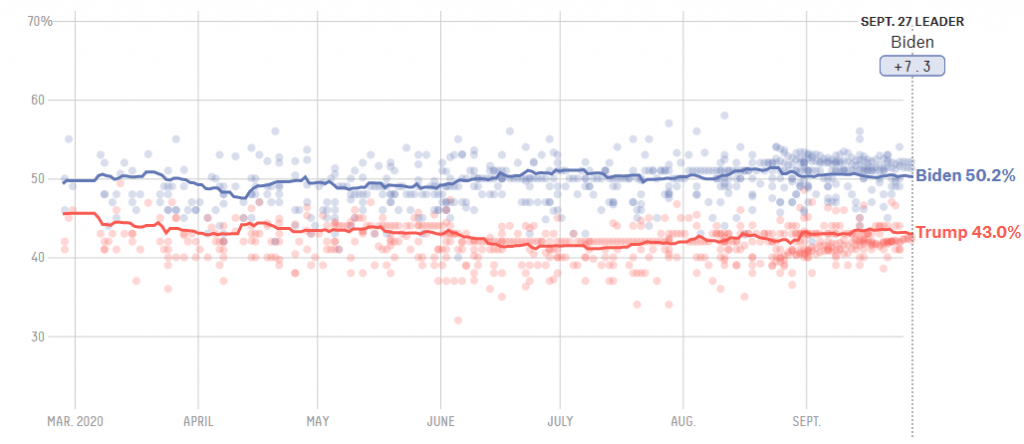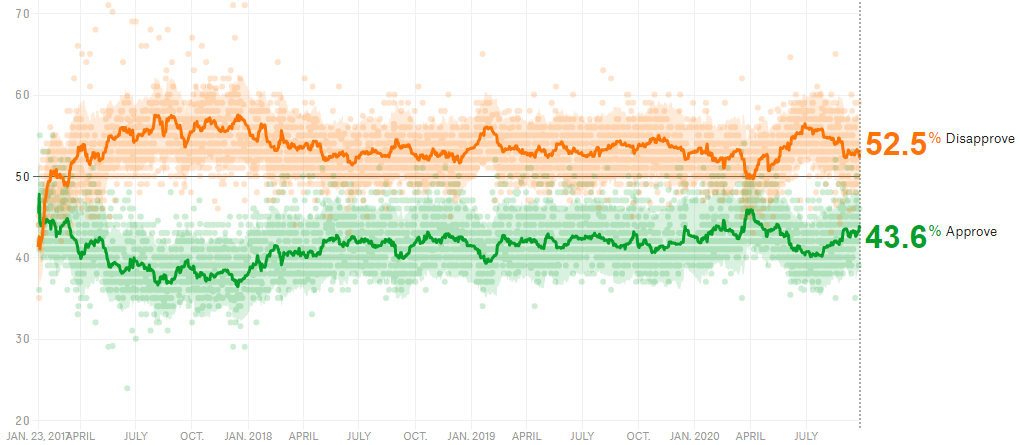Set by Congress in 1845[1], election day is always held on the first Tuesday after the first Monday in November. This year it falls on November 3.
US citizens aged 18 years and over are eligible to vote in the US elections. According to the Census Bureau[2], 245.5 million Americans aged 18 and over were eligible to vote in the November 2016 elections. However, only 157.6 million registered.
Understandably, Interest peaks as election time draws near, yet the route to the White House is often misunderstood.
Hopefully, this introductory piece will help clear up some of the confusion.
The US election process can be viewed in five phases:
- Primaries and Caucuses
- National Conventions
- Election Campaigns
- General Election
- Electoral College
Primaries and Caucuses
Every four years, US states hold primary elections or caucuses to select candidates to run for public office.
State and local governments determine which dates primary elections or caucuses are held, though this year there were some changes due to COVID-19.
- Primaries are run by state governments. An open primary permits registered voters to select whichever candidate they want, regardless of party affiliation. In a closed primary, however, voters must be registered with a political party and can only select a candidate within their selected party.
- Caucuses are elections run by political parties. In a caucus, party members select the best candidate through a series of discussions and votes.
Democrats and Republicans nominate their candidate at the party’s national conventions.
National Conventions
Often enormous affairs, a national convention is held by each party to select a first presidential nominee. It marks the end of the primary election and beginning of the general election.
Although the nominee is frequently known ahead of time, at each convention the presidential candidate chooses a running mate, a vice presidential candidate. Here, parties also determine a platform, a statement of policies they’ll implement should they win the election.
Election Campaign
Following the national conventions, presidential candidates campaign throughout the country to win the support of the general population.
The idea behind an election campaign is to provide a stage for parties to present their message (often containing a number of key issues surrounding policy) and ideas they want to share with voters. A party’s message is frequently repeated in order to drill home their position and create a lasting impression.
In today’s connected world, a candidate’s every word, action and expression are recorded and shared.
Political campaigns are expensive, with the majority of funding spent on television and radio commercials. Funding for election campaigns is derived from a number of resources, including tax payers.
General Election
The general election, as highlighted above, is held on the first Tuesday after the first Monday of November, every 4 years.
Voters in each state (indirectly) place their vote for one president and vice president. This is an aspect that often confuses voters.
The choice of each voter is reflected in what’s known as the popular vote – the president is not elected via popular vote.
Voters actually vote for a group of people called electors. The president (and vice president) is then selected by the Electoral College.
Electoral College
The electoral college, consisting of 538 electors who cast votes to decide the president and vice-president of the US, is a unique (and often confusing) method for electing a president.
For a candidate to become president at least 270 of the 538 possible votes must be secured.
Names of electors are not on the ballot in most states. Instead, when a voter casts a vote for a presidential candidate, they’re voting for the electors already selected by the party of that candidate. So, for example, if the majority of voters in a state vote for the Republican candidate, the Republican slate of electors is elected.
While the electoral college results usually support the popular vote, some notable outliers exist. The 2016 election is a recent example, in which Donald Trump won the electoral vote though was destroyed in the popular vote, but still became president of the US. Hillary Clinton, the democratic nominee, received nearly three million more popular votes.
Polls
As we cross over into October, the national polls, according to fivethirtyeight, reveal Joe Biden, the democratic nominee, leads by a little more than seven points over Republican president Donald Trump (figure A).
Incumbent President Donald Trump’s approval rating (an updating calculation of the president’s approval rating, accounting for each poll’s quality, recency, sample size and partisan lean – fivethirtyeight) is also below 50 percent (figure B).
Source: https://projects.fivethirtyeight.com/polls/president-general/national/ (Figure A)
Source: https://projects.fivethirtyeight.com/trump-approval-ratings/?cid=rrpromo (Figure B)
The accuracy, completeness and timeliness of the information contained on this site cannot be guaranteed. IC Markets does not warranty, guarantee or make any representations, or assume any liability regarding financial results based on the use of the information in the site.
News, views, opinions, recommendations and other information obtained from sources outside of www.icmarkets.com.au, used in this site are believed to be reliable, but we cannot guarantee their accuracy or completeness. All such information is subject to change at any time without notice. IC Markets assumes no responsibility for the content of any linked site.
The fact that such links may exist does not indicate approval or endorsement of any material contained on any linked site. IC Markets is not liable for any harm caused by the transmission, through accessing the services or information on this site, of a computer virus, or other computer code or programming device that might be used to access, delete, damage, disable, disrupt or otherwise impede in any manner, the operation of the site or of any user’s software, hardware, data or property.
[1] https://www.loc.gov/law/help/statutes-at-large/28th-congress/session-2/c28s2ch1.pdf
[2] https://www.census.gov/data/tables/time-series/demo/voting-and-registration/p20-580.html






